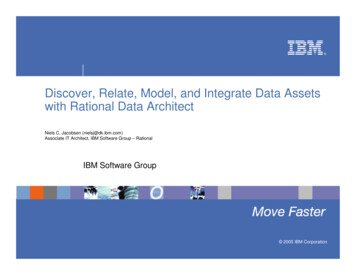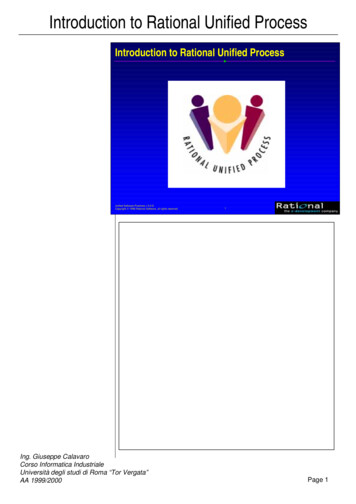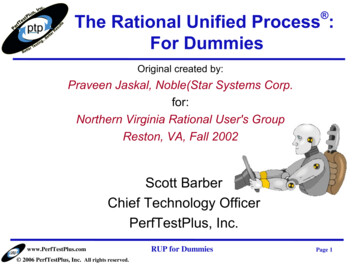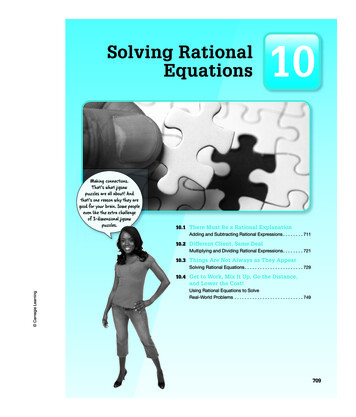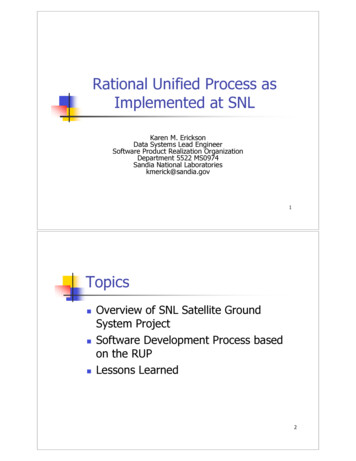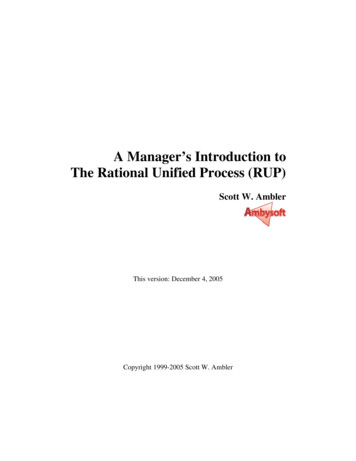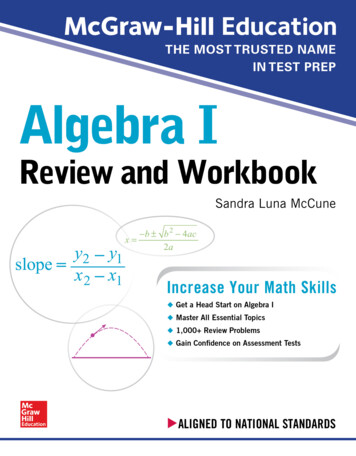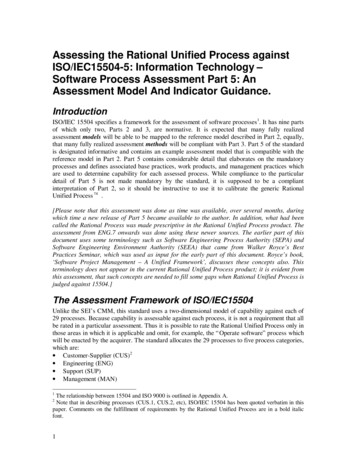
Transcription
Assessing the Rational Unified Process againstISO/IEC15504-5: Information Technology –Software Process Assessment Part 5: AnAssessment Model And Indicator Guidance.IntroductionISO/IEC 15504 specifies a framework for the assessment of software processes1. It has nine partsof which only two, Parts 2 and 3, are normative. It is expected that many fully realizedassessment models will be able to be mapped to the reference model described in Part 2, equally,that many fully realized assessment methods will be compliant with Part 3. Part 5 of the standardis designated informative and contains an example assessment model that is compatible with thereference model in Part 2. Part 5 contains considerable detail that elaborates on the mandatoryprocesses and defines associated base practices, work products, and management practices whichare used to determine capability for each assessed process. While compliance to the particulardetail of Part 5 is not made mandatory by the standard, it is supposed to be a compliantinterpretation of Part 2, so it should be instructive to use it to calibrate the generic RationalUnified Process TM .[Please note that this assessment was done as time was available, over several months, duringwhich time a new release of Part 5 became available to the author. In addition, what had beencalled the Rational Process was made prescriptive in the Rational Unified Process product. Theassessment from ENG.7 onwards was done using these newer sources. The earlier part of thisdocument uses some terminology such as Software Engineering Process Authority (SEPA) andSoftware Engineering Environment Authority (SEEA) that came from Walker Royce’s BestPractices Seminar, which was used as input for the early part of this document. Royce’s book,‘Software Project Management – A Unified Framework’, discusses these concepts also. Thisterminology does not appear in the current Rational Unified Process product; it is evident fromthis assessment, that such concepts are needed to fill some gaps when Rational Unified Process isjudged against 15504.]The Assessment Framework of ISO/IEC15504Unlike the SEI’s CMM, this standard uses a two-dimensional model of capability against each of29 processes. Because capability is assessable against each process, it is not a requirement that allbe rated in a particular assessment. Thus it is possible to rate the Rational Unified Process only inthose areas in which it is applicable and omit, for example, the “Operate software” process whichwill be enacted by the acquirer. The standard allocates the 29 processes to five process categories,which are: Customer-Supplier (CUS)2 Engineering (ENG) Support (SUP) Management (MAN)1The relationship between 15504 and ISO 9000 is outlined in Appendix A.Note that in describing processes (CUS.1, CUS.2, etc), ISO/IEC 15504 has been quoted verbatim in thispaper. Comments on the fulfillment of requirements by the Rational Unified Process are in a bold italicfont.21
Organization (ORG)Capability is rated for each process on a scale of 0 to 5, with 0 representing the lowest capability,labeled “incomplete”, up to the highest capability at 5, labeled “optimizing”. Each level ischaracterized by process attributes, common to all processes, the achievement of whichdetermines whether an assessed process reaches that level. The process attributes themselves arerated on a four-point scale, as:Nnot achieved - there is no evidence of achievement of the attributePpartially achieved - there is some achievement of the attributeLlargely achieved - there is significant achievement of the defined attributeFfully achieved – there is full achievement of the attribute.To be rated at a particular process capability level, the process attributes at that level must belargely or fully achieved, and the process attributes for all lower levels must be fully achieved.The Process DimensionEach process is described in the standard with two sections, one containing a statement of thepurpose of the process and its desired outcomes, and the other containing notes about the processand its relationship to ISO 12207.Customer-Supplier Process Category (CUS)This contains:CUS.1CUS.2CUS.3CUS.4CUS.5Acquire SoftwareManage Customer NeedsSupply SoftwareOperate SoftwareProvide Customer ServiceFor example (extract from ISO 15504 follows):CUS.1Acquire SoftwareThe purpose of the acquire software process is to obtain the product and/or service which willsatisfy the need expressed by the customer. The acquisition process is enacted by the acquirer.The process begins with the identification of a customer need and ends with the acceptance of theproduct and/or service needed by the customer. As a result of successful implementation of theprocess a contract will be developed which clearly expresses the expectation, responsibilities,and liabilities of both the supplier and the customer; a product and/or service will be produced which satisfies the customer need; the acquisition will be managed so that specified constraints (e.g. such as cost,schedule and quality) are met.Note – this process is identical in scope to the acquisition process, one of the primary life cycleprocesses in ISO 12207.Engineering Process Category (ENG)This contains:ENG.12Develop System Requirements and Design
ENG.2ENG.3ENG.4ENG.5ENG.6ENG.7Develop Software RequirementsDevelop Software DesignImplement Software DesignIntegrate and Test SoftwareIntegrate and Test SystemMaintain System and SoftwareSupport Process Category (SUP)This evelop DocumentationPerform Configuration ManagementPerform Quality AssurancePerform Work Product VerificationPerform Work Product ValidationPerform Joint ReviewsPerform AuditsPerform Problem ResolutionManagement Process Category (MAN)This contains:MAN.1MAN.2MAN.3MAN.4Manage the ProjectManage QualityManage RisksManage SubcontractorsOrganization Process CategoryThis contains:ORG.1ORG.2ORG.3ORG.4ORG.5Engineer the BusinessDefine the ProcessImprove the ProcessProvide Skilled Human ResourcesProvide Software Engineering InfrastructureThe Capability DimensionThe model defines how each of the processes (CUS.1, CUS.2, etc.) shall be rated along a sixpoint capability scale ranging from incomplete at the bottom to optimizing at the top. Themeasure of capability is based on a set of nine process attributes (PA) which are common to allprocesses. The process attributes are used to establish whether a particular process has reached acertain level of capability by measuring each attribute on a four-point scale as described above.Level 0: Incomplete ProcessAt this level, a process is not implemented fully or does not achieve its purpose. This level has noprocess attributes.Level 1: Performed ProcessAt this level, the process achieves its purpose as defined in the standard. There is a single processattribute that can be examined to determine the degree of achievement of this level (quoted fromthe standard):3
PA 1.1 Process Performance Attribute“The extent to which the execution of the process uses a set of practices that are initiatedand followed using identifiable input work products to produce identifiable output workproducts that are adequate to satisfy the purpose of the process.”Level 2: Managed ProcessThe performed process delivers work products of acceptable quality within defined timescalesand resource needs. There are two PAs at this level:PA 2.1 Performance Management Attribute“The extent to which the execution of the process is managed to produce work productswithin stated time and resource requirements.”PA 2.2 Work Product Management Attribute“The extent to which the execution of the process is managed to produce work productsthat are documented and controlled and that meet their functional and non-functionalrequirements, in line with the work product quality goals of the process.”Level 3: Established ProcessAt Level 3, the managed process is performed using a defined process based on good softwareengineering principles. There are two PAs at this level:PA 3.1 Process Definition Attribute“The extent to which the execution of the process uses a process definition based on astandard process, that enables the process to contribute to the defined business goals ofthe organization.”PA 3.2 Process Resource Attribute“The extent to which the execution of the process uses suitable skilled human resourcesand process infrastructure effectively to contribute to the defined business goals of theorganization.”Level 4: Predictable ProcessAt Level 4, the established process is performed consistently within defined control limits toachieve its goals. There are two PAs at this level:PA 4.1 Process Measurement Attribute“The extent to which the execution of the process is supported by goals and measures thatare used to ensure that implementation of the process contributes to the achievement ofthe goals.”4
PA 4.2 Process Control Attribute“The extent to which the execution of the process is controlled -- through the collectionand analysis of measures to control and correct, where necessary, the performance of theprocess -- to reliably achieve the defined process goals.”Level 5: Optimizing ProcessAt this level, the predictable process optimizes its performance to meet current and futurebusiness needs and achieves repeatability in meeting its defined business goals. There are twoPAs at this level:PA 5.1 Process Change Attribute“The extent to which changes to the definition, management, and performance of theprocess are controlled to better achieve the business goals of the organization.”PA 5.2 Continuous Improvement Attribute“The extent to which changes to the process are identified and implemented to ensurecontinuous improvement in the fulfillment of the defined business goals of theorganization.”Process Attribute RatingsOn the rating scale defined above, each process attribute (up to the highest capability level chosenfor the assessment) is given a rating for each process instance that is assessed. The model admitsthe possibility of a process instance having a process attribute at a higher level of capability witha higher rating than one at a lower level, but the overall rating for the process instance will be at,or below, the lower level.Additional Guidance in Part 5 of ISO 15504Process DimensionFor each process identified in the reference part of the standard, Part 5 adds a set of base practicesfor the process, which further refine the description of process purpose, and a list of input andoutput work products and their characteristics. Together these are indicators of processperformance. Evidence that the base practices are followed and the work products produced willtypically result in the process being rated (at least) at level one.Capability DimensionFor each process attribute specified in the reference model, Part 5 describes managementpractices that are indicators of achievement of the process attributes. Except at Level 1, wherethere is one PA and a single associated management practice, each PA has four associatedmanagement practices. Evidence of the effective use of these management practices is used toarrive at a rating for the performance attributes. Each management practice is characterized byattribute indicators covering: management practice performance characteristics that provide evidence that the practice isbeing performed;5
resource and infrastructure characteristics, the existence of which assists the performance ofthe practice and, by implication, without which the performance of the practice is much moredifficult; and associated processes from the process dimension that support the management practice.Mapping to the Rational Unified ProcessThe scope of the Rational Unified Process includes some discussion of management, customerinterface, and organizational issues, but it has most detail on engineering and support. Thisgeneric assessment nevertheless attempts to cover all the processes defined in the standard andindicates on which issues the Rational Unified Process is silent.Assessment of the Rational Unified ProcessCapability DimensionThe use of particular base practices and the existence and characteristics of particular workproducts will determine whether Level 1 is achieved. This assessment will be specific to eachprocess and is presented with the process in subsequent sections. The higher levels are notassessed here on a process-by-process basis because their achievement is too implementationspecific. To elaborate this point: this assessment only reflects the potential of the RationalUnified Process to achieve a particular capability level. It will still be possible for an instance ofthe process to fail to reach that potential. At Level 1, the Rational Unified Process is prescriptiveenough to be able to find clear mappings to most base practices and work products in Part 5 –where mappings do not clearly exist, the Rational Unified Process has been rated as notachieving Level 1 (N), that is, not having the potential, without augmentation, to reach Level 1.At higher levels of capability, the potential of the Rational Unified Process has been assessedoverall, because, in the main, only guidelines are presented in the Rational Unified Process atthese levels. An organization will therefore have to do more work to realize these levels ofcapability. Again, this assessment is couched in terms of the potential level of capability. So if,for example, the potential of the Rational Unified Process overall was assessed at Level 3, then aninstance of any process (CUS.1, ENG.2, etc), which was individually assessed as fully achievingLevel 1, could achieve Level 3.Level 2: Managed ProcessPA 2.1 Performance Management AttributeThe extent to which the execution of the process is managed to produce work products withinstated time and resource requirements. In order to achieve this capability, a process needs to have time and resources requirementsstated and produce work products within the stated requirements.Management Practice 2.1.1:Identify resource requirements to enable planning and tracking of the process.The Rational Unified Process requires the collection of a number ofpragmatic metrics which are the means of assessing progress to date and thebasis for cost and schedule estimation. Although the Rational Unified Processdoes not contain a sizing or estimation tool or method, it recommends theuse of COCOMO 2.0 as a state-of-the-art example. The Rational UnifiedProcess also mandates periodic status assessments when progress and riskare to be reviewed. The Rational Unified Process expects that project6
planning and reporting tools will be used to construct a plan and reportprogress against it. The Rational Unified Process expects that planningpractice and procedures will be captured in Organizational Policy andProcedures, on which all projects will base their performance.Management Practice 2.1.2:Plan the performance of the process by identifying the activities of the process and theallocated resources according to the requirements.The Rational Unified Process defines a set of Work Breakdown Structures(WBS) to which the estimated effort and schedule should be allocated. Thisactivity will occur as part of the construction of the Development Plan. TheDevelopment Plan – conforming to Organizational Policy - will also contain: elaboration of the development approach, methods and lifecycle; details of the Software Development Environment (hardware,software, and other facilities); a Risk Management Plan; and references to applicable standards.Management Practice 2.1.3:Implement the defined activities to achieve the purpose of the process.This assessment of the generic Rational Unified Process cannot determinewhether planned activities will be performed in a particular instance,however, the Rational Unified Process does define requirements formilestones and reviews which will allow implementation to be policed. TheRational Unified Process also recommends the use of automation to enact theprocess, “so doing the right, planned thing is automatic”.Management Practice 2.1.4:Manage the execution of the activities to produce the work products within stated timeand resource requirements.The Rational Unified Process requires the collection of metrics which areused to track progress and emerging product quality. Both absolute valuesand trends in the metrics are captured and presented to management at leastas often as the periodic status assessment. The Rational Unified Process alsohas rigorous Change Management as one of its key themes, so that oncecorrections are identified they can be tracked and closed. It is also one of thetasks of the Software Engineering Process Authority to ensure thatOrganizational Policy (with respect to process) is enforced and that, wherenecessary, the process is improved. The Rational Unified Process treats allkey artifacts, plans, policy documents, standards, etc, as subject to changecontrol. The Rational Unified Process is also built around demonstrationagainst agreed evaluation criteria as a key mechanism of objective closure oftasks and iterations, as well as a significant risk reduction mechanism.PA 2.2 Work Product Management AttributeThe extent to which the execution of the process is managed to produce work products that aredocumented and controlled and that meet their functional and non-functional requirements, in linewith the work product goals of the process.7
In order to achieve this capability, a process needs to have stated functional and nonfunctional requirements, including integrity, for work products and to produce work productsthat fulfill the stated requirements.Management Practice 2.2.1:Identify requirements for the integrity and quality of the work products.The Rational Unified Process expects that Organizational Policy will dictatethe overall strategy for quality management and identify acceptable standardswhich individual projects will employ. These will be made concrete in theDevelopment Plan and in the Evaluation Criteria set for each iteration.Product integrity is addressed in the Rational Unified Process through itsfocus on rigorous change management and configuration control. TheRational Unified Process view is that quality engineering is an integral part ofthe development process, made real through the metrics program anddemonstration as the primary means of assessment. Reviews, inspections,and the like are required by the Rational Unified Process but are regarded assecondary in their quality impact. The artifact set defined in the RationalUnified Process makes provision for definition of all types of requirements –functional, non-functional, and quality.Management Practice 2.2.2:Identify the activities needed to achieve the integrity and quality requirements for workproducts.The Rational Unified Process requires the Development Plan to describe howconfiguration management and change control will be implemented. Allquality-related activities will also be planned and captured in theDevelopment Plan. As mentioned under MP 2.2.1, the Rational UnifiedProcess uses demonstration (and use) of products, along with a qualitymetrics program, as the main means of achieving quality objectives.Management Practice 2.2.3:Manage the configuration of work products to ensure their integrity.This Management Practice is the implementation of the integrityrequirements of MP 2.2.2 and therefore could only be assessed in use. Toassist in the implementation, the Rational Unified Process stronglyrecommends the use of automation for Configuration Management andChange Control.Management Practice 2.2.4:Manage the quality of work products to ensure that the work products meet theirfunctional and non-functional requirements.This Management Practice is the implementation of the quality requirementsof MP 2.2.2 and therefore could only be assessed in use.RatingIt seems clear that the Rational Unified Process has the intrinsic capability to be deployed atLevel 2: on the basis of the required management practices both PA 2.1 and PA 2.2 are fullyachieved.8
Level 3: Established ProcessPA 3.1 Process Definition AttributeThe extent to which the execution of the process uses a process definition based on a standardprocess that enables the process to contribute to the defined business goals of the organization. In order to achieve this capability, a process needs to be executed according to a standardprocess definition that has been suitably tailored to the needs of the process instance. Thestandard process needs to be capable of supporting the stated business goals of theorganization.Management Practice 3.1.1Identify the standard process definition from those available in the organization that isappropriate to the process purpose and the business goals of the organization.The Rational Unified Process requires an organization to define processstandards in organizational policy and from these standards a particularproject will construct process instances tailored to suit project-specificrequirements. The Rational Unified Process defines the detailed processframework from which instances shall be constructed. This genericframework includes task descriptions, identification of workers, workflow,completion criteria, work products, metrics, and milestones. The RationalUnified Process does not contain any built-in values for productivity ormetrics targets, or any detailed estimation guide for process components andactivities. The use of tools to automate process performance is a recurringtheme in the Rational Unified Process; Rational produces tools fordocumentation automation, process enactment, configuration and changemanagement, requirements capture, and design and test automation. TheRational Unified Process is documented in paper and HTML form.Management Practice 3.1.2Tailor the standard process to obtain a defined process appropriate to the process context.The Rational Unified Process has detailed guidelines for processconfiguration and tailoring, in fact, process configuration is a requiredactivity in process deployment. The guidelines include a rationale fordecision-making for each of the process components.Management Practice 3.1.3Implement the defined process to achieve the process purpose consistently, andrepeatably, and support the defined business goal of the organization.This practice is implementation-instance dependent and the Rational UnifiedProcess does have associated training material. Having an HTML versionmakes the process accessible and permits integration with other tools.Management Practice 3.1.4Provide feedback into the standard process from experience of using the defined process.Again, the actualization of this practice will depend on the particularimplementation; the Rational Unified Process emphasizes iterativedevelopment cycles, each of which concludes with an assessment based oncost/schedule and quality metrics. This assessment will consider bothproduct and process implications for subsequent iterations. Results arecaptured in an Iteration Assessment artifact. It is the responsibility of theProject Manager and the Software Engineering Process Authority to ensure9
that the results are analyzed and, where appropriate, fed back intoOrganizational Policy, and fed forward into the next iteration.PA 3.2 Process Resource AttributeThe extent to which the execution of the process uses suitable skilled human resources andprocess infrastructure effectively to contribute to the defined business goals of the organization. In order to achieve this capability, a process needs to have adequate human resources andprocess infrastructure available that fulfill stated needs to execute the defined process.Management Practice 3.2.1Define the human resource competencies required to support the implementation of thedefined process.The Rational Unified Process expects that a Development Plan will becreated which contains a staffing plan that shows numbers, durations, andskills. This plan will be derived from the Organizational Policy’s tailoring ofthe generic process to reflect the available skill base. The generic process alsoidentifies workers and their responsibilities for each activity but is not explicitabout the skills or experience required.Management Practice 3.2.2Define process infrastructure requirements to support the implementation of the definedprocess.The Rational Unified Process requires that a standard software engineeringenvironment be established as part of organizational policy. The RationalUnified Process describes the characteristics of the minimum environmentincluding the requirement that it provide access to the reusable assets of anorganization. The Software Engineering Environment Authority isresponsible for the implementation of the organization’s engineeringenvironment policy and for assisting Project Managers in setting upcompliant environments for their projects. The Software Development Planwill document project specific requirements and deviations from theorganizational standard. The detail of what is required to satisfy this practiceis defined under the Rational Unified Process component ‘Environment’.Management Practice 3.2.3Provide adequate skilled human resources meeting the defined competencies.This practice is in fulfillment of the plans produced in MP 3.2.1. The RationalUnified Process does not cover human resource selection and monitoring.The Rational Unified Process recognizes the need for training and hastraining materials covering process, methods, and tools.Management Practice 3.2.4Provide adequate process infrastructure according to the defined needs of the process.This practice is in fulfillment of the plans produced in MP 3.2.2. The RationalUnified Process requires that planning for the acquisition of a projectSoftware Engineering Environment (SEE) be described in the SoftwareDevelopment Plan (SDP). This, along with all other plans, is subject toperiodic status assessment. The Project Manager and then SoftwareEngineering Environment Authority (SEEA) will decide if changes need tobe made in the light of increased demand or changing technology. The10
Rational Unified Process covers infrastructure support generally but is notprescriptive about the day-to-day tracking and monitoring of SEE use.RatingSome omissions from the Rational Unified Process (in areas it was not designed to cover) preventfull achievement of these attributes. PA 3.1 and PA 3.2 are therefore rated as largely achieved.Consequently, according to the rating rules of ISO 15504, the highest rating that any ofCUS.1, ENG.1, etc. can achieve under the Rational Unified Process, without addition, isLevel 3: Established Process, even though some of the characteristics of Level 4 and Level 5may be present.Level 4: Predictable ProcessPA 4.1 Process Measurement AttributeThe extent to which the execution of the process is supported by goals and measures that are usedto ensure that implementation of the process contributes to the achievement of the goals. In order to achieve this capability, a process needs to have goals and associated measuresdefined that enable the execution of the process to be controlled to achieve the goals.Management Practice 4.1.1Define process goals and associated measures that support the business goals of theorganization.The Rational Unified Process does not have predefined process goals butdoes define a set of pragmatic measures relevant to schedule, expenditure,and quality. However, goals will be set in a project context and will be relatedto the accomplishment of an iteration. Trends are deemed as, or more,important than absolute values. The Rational Unified Process does notspecify the use of particular statistical process control techniques. Themetrics specified by the Rational Unified Process are also (deliberately)focused on actual software product and less on the artifacts of the processes.The practice performance characteristics for MP 4.1.1 suggest a level ofquantification detail and granularity that is not supported by the RationalUnified Process.Management Practice 4.1.2Provide adequate resources and infrastructure for data collection.The Rational Unified Process expects that the collection of metrics will belargely automated if it is to be effective. The Rational Unified Process doesnot describe in any detail additional infrastructure or resources for the level ofdetail intended at Level 4.Management Practice 4.1.3Collect the specified measurement data from the implementation of the defined process.This practice is the fulfillment of MP 4.1.1. Again, the focus in the RationalUnified Process is on the evaluation of the results of an iteration - thesoftware - so there is a difference in emphasis.Management Practice 4.1.4Evaluate achievement of process goals by comparison of recorded measures.11
The level of evaluation required by the Rational Unified Process is against theplan for each iteration. The granularity of assessment of goal achievementwill be coarser.PA 4.2 Process Control AttributeThe extent to which the execution of the process is controlled through the collection and analysisof measures to control and correct, where necessary, the performance of the process to reliablyachieve the defined process goals. In order to achieve this capability, a process needs to gather and analyze process measures toensure that the execution of the process is controlled to achieve the process goals.Management Practice 4.2.1Identify analysis and control techniques appropriate to the process context.The Rational Unified Process is not prescriptive at this level. The analysisrecommended is of trends of metrics which mainly derive from softwareproduct rather than process artifacts.Management Practice 4.2.2Provide adequate resources and infrastructure for analysis and process control.The kinds of analysis and corrective action required by the Rational UnifiedProcess are within the capability
The scope of the Rational Unified Process includes some discussion of management, customer interface, and organizational issues, but it has most detail on engineering and support. This generic assessment nevertheless attempts to cover all the processes defined in the standard and indicates on which issues the Rational Unified Process is silent .


